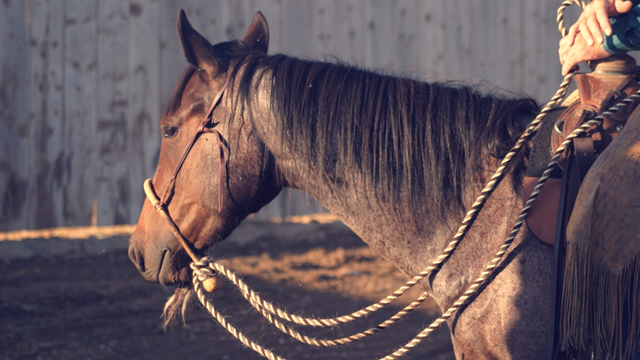Written by Martin Black
This article originally appeared in Eclectic Horseman Issue No.23
Doubling isn’t a maneuver you would see in a reining pattern, dressage class, cow horse event, or any other advanced performance competitions. But if it is the first maneuver a horse learns and maintains properly, it can help prevent a lot of mishaps and undesirable patterns.
The horse needs to learn to perform this maneuver properly and completely; bits and pieces now and then will only give the horse and rider a false sense of security. Different people may have a different interpretation or understanding of doubling; I will define mine and the importance of it.
Starting with the tip of the horse’s nose, regardless of whether the colt was started in a snaffle, hackamore, or halter, as the slack is drawn out of the rein, the horse should tip his nose toward the rein with a slight bend in the poll. One of the most important things to look for is if the horse is supple in the poll. If the horse is not supple in the poll, he will not be supple in the loin and he will be braced mentally. All three work together, simultaneously, and no training device can get this until the horse is ready to give it. Most horses will give this with very little challenge if we haven’t given them a reason to be defensive. A horse can bend his neck until their nose touches the saddle but if the poll is straight the loin will be also, Mentally he is defensive, his guard is up so he is ready to push forward with the hindquarters. The poll is straight so he can see a flight path.
The shoulder can be falling to the outside or to the inside; in either case this can be a dangerous position to be in. The horse will be pushing forward with the hind feet extending back more than a normal stride, which puts more weight on the front feet. The horse is not balanced in any sense of the word, and if the horse were to stumble in front, it’s difficult to make a recovery because the other three feet are behind the center of gravity. Again loin, poll, and mind all working simultaneously is like having three different meters. If you can read one, the other two will read the same. In most of the defensive maneuvers a horse uses against us, running, bucking, rearing, etc., the hindquarters are engaged, and locked, and the loin is straight.
When the horse is broke in the poll, and in the loin, and if the nose is pointed to some degree to the left, the hind feet will be stepping to the right. When the horse can do this consistently and with some confidence, the inside hind feet will be reaching up under toward the girth, and the inside front would be stepping shortest or pivoting while the other three feet maintain a forward motion. Regardless of how this is achieved, to me there is little room to compromise. This is the one thing that will help ensure you don’t lose control and most importantly, maintain safety for the rider and horse before leaving the round pen.
Some horses while moving in a straight line at a slow pace may stop the front feet or even step them back when the hind feet step out. This will not benefit the doubling because the horse may have trouble going from a forward motion with speed and shift his weight back if he is too scared to stop in front so the hind feet can step out.
If the horse knows how to step the hind feet out while at any speed, the horse can be doubled; and because the feet are reaching forward, they can maintain their balance. The slower the horse is going, the farther he can reach out, but at any speed he can disengage or quit pushing with the hindquarters and shift them to the outside of the line of travel. When done properly, the doubling maneuver can prevent a horse from bucking or running out of control and, with a slightly different presentation, can help prepare the horse for a rollback or a sliding stop later on.
This article originally appeared in Eclectic Horseman Issue No.23



